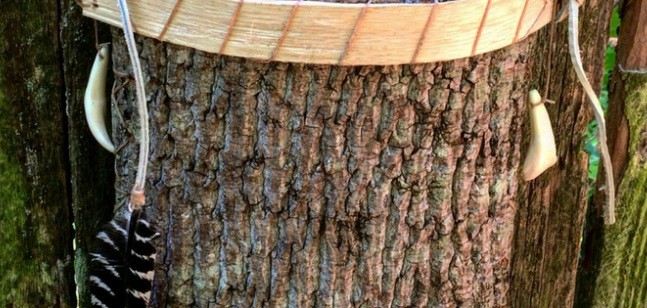Need to go berry-gathering and don't have a bucket? Or do you simply want a fun bushcraft project to work on? Either way, take a look at the tutorial below and get started on tree bark bucket-making.
Material and Tools
Knife – about all you really need
Ax or saw if you plan to fell a tree
Awl or drill
Cordage
Rim woodFind the Right Tree
Tulip Poplar is a fast growing (soft) hardwood with many uses in the southeastern United States. Other candidates for bark containers include; basswood, cedar, white birch and others.Score and Skin
Score the bark down to the sapwood with a knife or hatchet. I use a solid stick to strike the back of the blade after a free-hand score mark has been applied to the bark.
Once scored, press the tip of your knife into one corner and lift to separate the outer and inner bark from the sapwood. From that point, I use a wedged stick to run along the edge to loosen and lift the bark. With a gap created, you can use your fingers to further separate the bark from the tree.Cut to Length
Place the bark flat on a level surface and cut to length. The length of bark should be a bit over double the intended height of your bucket. Trim all edges smooth to create a long rectangle.
Bark length should be double that of the intended height of your containerScore a Football
With the outer bark facing up, measure and mark the mid-point of each long side of the rectangle. Use your knife to score an arch which runs from side to side. Repeat this step to form a football shape on the outer bark. Be careful to not cut through the inner bark. This layer of bark acts as a hinge when folding the basket sides together.
The size of the “football” determines the opening size at the top
Turn the bark over with the inner bark facing up. Place your hand on the middle of the bark and gently pull one long end to a vertical position. Now fold the other side. Your berry bucket is taking shape.Bore Edge Holes
Use an awl or drill to bore a line of holes on both edges of the bucket. The hole diameter should be large enough to accept your cordage/lacing.Lace Edges
Artificial sinew makes strong lacing. It can be purchased online or at craft stores.
Start lacing at the bottom edge near the football cut with the edges joined together. Tie off with a simple overhand knot and run the stitching up the edge. Make a pattern if you like. Secure the lace at the top of both seams.Add a Rim
Cut a flexible stick long enough to form a rim around the top opening of your bucket. The rim will prevent the bark from curling in as it dries.
Bore another series of holes along the rim edge. Place the rim wood pieces on the edges and lace them in as you did the sides.
What makes this project great is that it's incredibly versatile. You can use it for either making the berry bucket mentioned or you can make a quiver for your arrows or even a sheath for your knife.
All you need to do in order to build crafts with bark is to assess how much bark you need, the size of container you need, and how well the project could work for its intended purpose. Other than that, let your imagination run wild.
For more on this subject and other awesome builds, check out Survival Sherpa.
Featured Image via Survival Sherpa

3 different pages and still no video. just ads.